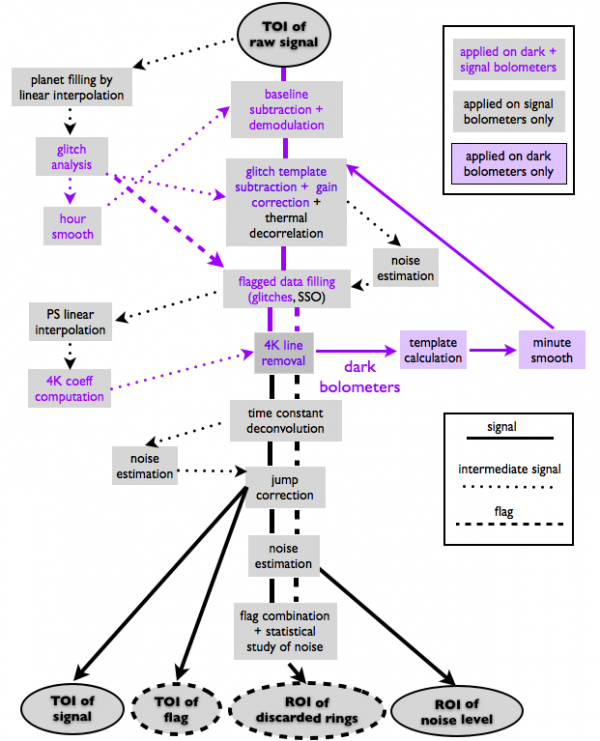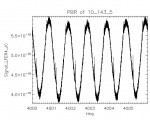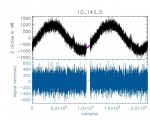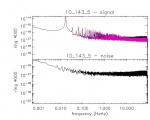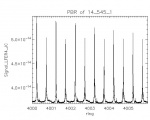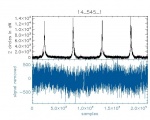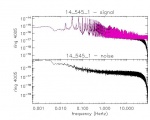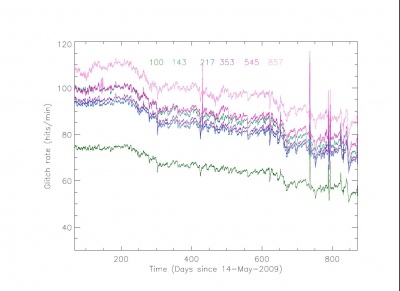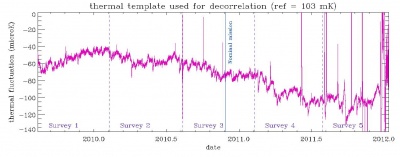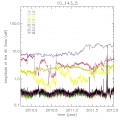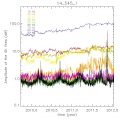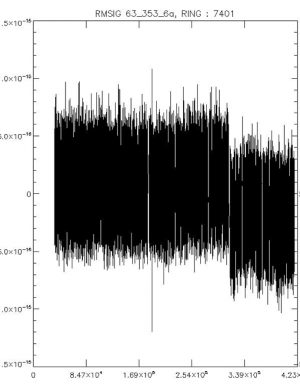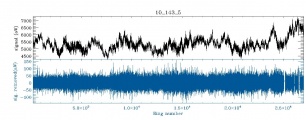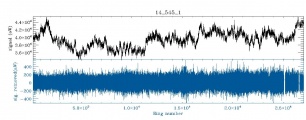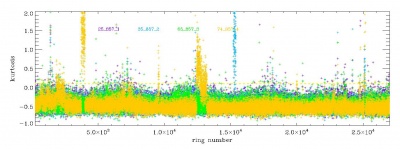Difference between revisions of "TOI processing"
| Line 89: | Line 89: | ||
- The point-source flag (PSflag): | - The point-source flag (PSflag): | ||
| − | An earlier version of HFI point-source catalog is read back into a flag TOIs, at a given frequency. In practice, 5 sigma sources are masked within a radius of 1.3 FWHM | + | An earlier version of HFI point-source catalog is read back into a flag TOIs, at a given frequency. In practice, 5 sigma sources are masked within a radius of 1.3 FWHM (9, 7, 5, 5, 5, 5 arcmin at 100,143,217,353,545,857 GHz) |
- the galactic flag (Galflag): | - the galactic flag (Galflag): | ||
| − | An earlier version of HFI maps is thresholded and apodized. The produced masks are read into flag TOIs. The retained threshold corresponds to a sky coverage of respectively 90, 90, 90 | + | An earlier version of HFI maps is thresholded and apodized. The produced masks are read into flag TOIs. The retained threshold corresponds to a sky coverage of respectively 70, 70, 80, 90, 90, 90% at 100,143,217,353,545,857 GHz. |
- Solar System Object flag (SSO flag) | - Solar System Object flag (SSO flag) | ||
| − | 4 | + | For the TOI flag, Mars, Jupiter, Saturn are flagged up to a radius of NbBeam= 2,3,3,4,4,4 times the fiducial FWHM (FWHM= 9, 7, 5, 5, 5, 5 arcmin at 100,143,217,353,545,857 GHz) |
| − | |||
| − | + | As an input to planet mask for maps, Mars, Jupiter, Saturn are flagged using a Coefficient depending on the planet (Factor_per_source) times NbBeam2 times FWHM | |
| − | + | with | |
| − | |||
| − | |||
Factor_per_Source1 = 1.1 (Mars) | Factor_per_Source1 = 1.1 (Mars) | ||
Factor_per_Source2 = 2.25 (Jupiter) | Factor_per_Source2 = 2.25 (Jupiter) | ||
Factor_per_Source3 = 1.25 (Saturn) | Factor_per_Source3 = 1.25 (Saturn) | ||
| − | |||
| − | |||
| − | |||
| − | |||
| − | |||
| − | + | NbBeam2 = 2.25 100 GHz | |
| − | + | NbBeam2 = 4.25 | |
| − | + | NbBeam2 = 4.0 | |
| + | NbBeam2 = 5.0 | ||
| + | NbBeam2 = 6.0 857 GHz | ||
| + | |||
| + | A small trailing tail is added to the mask to take into account the non-deconvolution of the planet signal which has been replaced by background values. The width of that tail is 10 % of the main flag diameter. The number of samples which are flagged are Factor_per_Source2 * AddSNafter | ||
AddSNafter1 = 10 100 GHz | AddSNafter1 = 10 100 GHz | ||
AddSNafter2 = 30 | AddSNafter2 = 30 | ||
| Line 121: | Line 117: | ||
AddSNafter4 = 20 | AddSNafter4 = 20 | ||
AddSNafter5 = 30 | AddSNafter5 = 30 | ||
| − | AddSNafter6 = 40 | + | AddSNafter6 = 40 857 GHz |
| − | |||
| − | |||
| − | |||
| − | |||
| − | |||
=== Output flags === | === Output flags === | ||
Revision as of 15:22, 19 October 2012
This Section is kept short as this Planck release does not contain TOIs. The main information in the HFI processing paper is not duplicated here.
Contents
Overview[edit]
We describe here the how the TOIs are processed in order to be used for map production. We do not repeat the general features of the pipeline which are given in the HFI Data Processing article (REF). Here we give complementary explanations on some details. The TOI of each bolometer is processed independently of the other bolometers, so as to keep the noise properties as uncorrelated as possible. The processing involves modifying the TOI itself for what concerns the conversion to absorbed power and the correction of glitch tails. It also adds a flag TOI that masks the TOI samples that are not to be projected on maps for various reasons.
Input TOI[edit]
The input TOI consists in the AC modulated voltage output of the readout of each bolometer. The input has previously been decompressed, and converted from internal digital units to voltage via a constant factor. The TOI has a regular sampling at the acquisition frequency of facq=180.373700+-0.000050 Hz. There are almost no missing data in the TOIs, except for few hundred samples of 545 and 857GHz TOIs which are lost in the on-board compression due to saturation on the Galactic Center crossings.
General Pipeline Structure[edit]
The next figure shows how the initial ccTOI is transformed and how flags are produced:
Output TOIs and products[edit]
A TOI of clean calibrated samples (ccTOI) and a combined flag TOI (fTOI) are the outputs of the processing. The ccTOI is calibrated so as to represent the instantaneous power absorbed by the detector. It is worth mentioning how the ccTOI is changed with respect to the input TOI, beyond the harmless constant conversion factor from voltage to absorbed power. The demodulation stage allows to get the demodulated bolometer voltage. The non-linearity correction is a second-order polynomial correction based on the physical but static bolometer model. In order to avoid too much masking after glitches, a glitch tail is subtracted after an occurrence of a glitch in the TOI. Finally, the temporal response of the bolometer is deconvolved. This affects mostly the high-temporal frequency part of the TOI, although a small but significant low frequency tail is corrected too. Although flagged samples are not projected, their value influences the valid samples somehow. Hence interpolation procedures introduce some indirect modifications of the TOI. The flag TOI is a combination a dozen flags with an OR logic. Only unflagged data are projected. The exhaustive list of flags is given here: CompressionError, NoData, SSO, UnstablePointing, Glitch, BoloPlateFluctuation, RTS, Jump, PSBab. A complete qualification of the data is obtained at the ring level. If the TOI shows an anomalous behaviour during the duration of a ring, this ring is discarded from projection.
Examples of clean TOIs[edit]
TBD: raw TOIs plot
Samples of PBR, TOIs, and PSDs of all detectors are shown in this file
Trends in the output processing variables[edit]
Here we intend to show the trend of the systematic effects that are dealt with in the TOI processing
Glitch statistics[edit]
For details, see copap. TBD : Fig. percentage of flagged data per bolometer (mostly due to CR).
Thermal template for decorrelation[edit]
A simple linear decorrelation is performed using the 2 dark bolometers as a proxy of the bolometer plate temperature. Coupling coefficients were measured during the CPV phase.
4K cooler lines variability[edit]
The amplitude of the nine 4K cooler lines in aW at 10, 20, 30, 40, 50, 60, 70, 80 and 17 Hz is shown for 2 bolometers in the following figures. The trend is smoothed over 31 ring values after having discarded measurements done at a ring which is discarded for all bolometers.
- Amplitude of the nine 4K cooler lines
The 4K cooler line coefficients of all bolometers are shown in this file
jump correction[edit]
A piecewise constant value is removed to the TOI if a jump is detected. See the example in the figure.
Trends in noise and signal[edit]
TBD: ADC baseline (one sample per hour) per bolometer
- Signal (top) and noise (bottom) smoothed at 1 minute. All values falling in a discarded ring are not plotted.
The smooth TOIs of all detectors are shown in this file
Noise stationarity[edit]
TBD Noise power spectrum: examples (Andrea)
TBD rms per ring corrected by ring duration bias: One per bolo, only valid rings, Smoothed version.
Flag description[edit]
Input flags[edit]
These flags are used as inputs to the TOI processing
- The point-source flag (PSflag):
An earlier version of HFI point-source catalog is read back into a flag TOIs, at a given frequency. In practice, 5 sigma sources are masked within a radius of 1.3 FWHM (9, 7, 5, 5, 5, 5 arcmin at 100,143,217,353,545,857 GHz)
- the galactic flag (Galflag):
An earlier version of HFI maps is thresholded and apodized. The produced masks are read into flag TOIs. The retained threshold corresponds to a sky coverage of respectively 70, 70, 80, 90, 90, 90% at 100,143,217,353,545,857 GHz.
- Solar System Object flag (SSO flag)
For the TOI flag, Mars, Jupiter, Saturn are flagged up to a radius of NbBeam= 2,3,3,4,4,4 times the fiducial FWHM (FWHM= 9, 7, 5, 5, 5, 5 arcmin at 100,143,217,353,545,857 GHz)
As an input to planet mask for maps, Mars, Jupiter, Saturn are flagged using a Coefficient depending on the planet (Factor_per_source) times NbBeam2 times FWHM with Factor_per_Source1 = 1.1 (Mars) Factor_per_Source2 = 2.25 (Jupiter) Factor_per_Source3 = 1.25 (Saturn)
NbBeam2 = 2.25 100 GHz NbBeam2 = 4.25 NbBeam2 = 4.0 NbBeam2 = 5.0 NbBeam2 = 6.0 857 GHz
A small trailing tail is added to the mask to take into account the non-deconvolution of the planet signal which has been replaced by background values. The width of that tail is 10 % of the main flag diameter. The number of samples which are flagged are Factor_per_Source2 * AddSNafter AddSNafter1 = 10 100 GHz AddSNafter2 = 30 AddSNafter3 = 20 AddSNafter4 = 20 AddSNafter5 = 30 AddSNafter6 = 40 857 GHz
Output flags[edit]
with and without point-sources, identical to a and b PSBs.
Flags produced for the map making :
UnstablePointing Flag OR FlagTOIproc OR SSOflag 4 map OR SSOflag seen
FlagTOIproc = glitch OR jump OR flag thermal template
If PSB flag glitch = flag glitch A OR flag glitch B
Flag used in the destriping: same + point-source flag
output TOI description[edit]
(Planck) High Frequency Instrument
Solar System Object
random telegraphic signal
To be defined / determined
Calibration and Performance Verification
sudden change of the baseline level inside a ring
analog to digital converter
Full-Width-at-Half-Maximum
